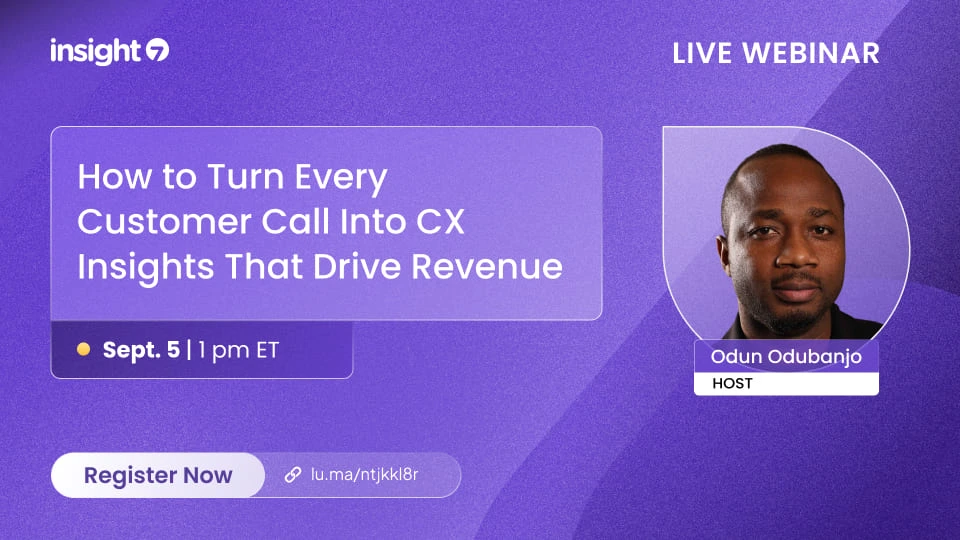Consumer Insight Analytics: Key Takeaways
-
Bella Williams
- 10 min read
Behavioral insights play a vital role in consumer insight analytics, providing organizations with a clearer understanding of consumer motivations. By studying behavioral patterns, companies can grasp the underlying factors that influence purchasing decisions. This knowledge is transformative, helping to tailor products and marketing strategies that resonate with consumers on a personal level.
To effectively harness these behavioral insights, businesses should follow several important steps. First, data collection is essential, encompassing qualitative and quantitative methods to gather comprehensive information. Second, insight extraction involves analyzing this data to identify trends and consumer preferences. Finally, the strategic application of these insights can guide decisions and enhance marketing efforts. When implemented correctly, businesses can see significant improvements in customer engagement and satisfaction, leading to stronger relationships and increased loyalty. The journey of understanding is ongoing, making consistent analysis imperative for sustained success.
Introduction to Behavioral Insights in Consumer Insight Analytics
Behavioral insights play a crucial role in understanding how consumers make decisions and interact with products. By examining these insights, businesses can uncover the motivations, preferences, and challenges that shape consumer behavior. This understanding is essential for tailoring marketing strategies and enhancing customer experiences, ultimately leading to improved engagement and sales.
Delving into behavioral patterns reveals the nuances in consumer journeys, allowing organizations to identify key touchpoints for meaningful interactions. By analyzing these insights, businesses can adapt their offerings and communication methods to align with consumer expectations, fostering trust and loyalty. Understanding behavioral insights is not just beneficial; it is imperative for organizations seeking to thrive in today’s competitive marketplace.
Generate visualizations from your qualitative data. At Scale.

The Role of Behavioral Insights in Understanding Consumers
Behavioral insights play a critical role in understanding consumers by uncovering the underlying motivations behind their actions. Analyzing consumer behavior reveals patterns that indicate not just what consumers do, but why they make those choices. For instance, subtle cues in consumer interactions can highlight preferences that traditional analytics may overlook. This deeper comprehension equips businesses with the tools to tailor their offerings, ensuring that they resonate with targeted audiences.
Furthermore, applying these insights helps organizations refine their marketing strategies. By recognizing the emotional triggers that influence consumer decisions, companies can develop messaging that strikes a chord with potential customers. This alignment between consumer behavior and business strategy fosters a more personalized experience, enhancing customer satisfaction and loyalty. Ultimately, behavioral insights serve as a bridge that connects data-driven strategies with the real-world behaviors of consumers, driving meaningful engagement and conversion.
Understanding the Consumer Journey
Understanding the consumer journey involves mapping out the steps that individuals take from awareness to decision-making. It is essential to recognize how these stages impact consumer behavior, which is influenced by various factors such as needs, preferences, and pain points. By analyzing these stages, businesses can gain valuable behavioral insights that inform marketing strategies and improve customer experiences.
In this journey, consumers undergo different emotional and rational assessments that shape their purchasing decisions. Each touchpoint presents opportunities for brands to engage and meet their needs effectively. Understanding how users interact with products and services allows companies to identify friction points and improve their offerings, ultimately leading to enhanced customer satisfaction and loyalty. Charting this journey enables organizations to adapt and respond to consumer behaviors, fostering a more personalized experience that resonates with their audience.
Analyzing Consumer Behavior Patterns
Understanding the nuances of consumer behavior patterns is essential for any business aiming to enhance customer experience. By analyzing these patterns, organizations can uncover the driving forces behind purchasing decisions. A comprehensive approach can help identify what influences customers, whether it’s brand loyalty, pricing strategies, or product availability.
Several key factors contribute to effective analysis of consumer behavior. First, tracking engagement metrics allows businesses to identify trends in consumer preferences over time. Second, segmenting audiences based on their behavior provides insight into distinct consumer profiles, helping tailor marketing strategies. Finally, conducting sentiment analysis on customer feedback reveals emotional responses, informing product development and service improvements. Together, these insights form a complete picture of consumer behaviors, enabling brands to adapt and thrive in a competitive market.
Evaluate Performance on Customer Calls for Quality Assurance.
Leveraging Behavioral Insights for Improved Business Strategies
Businesses today face the challenge of interpreting vast amounts of consumer data. Behavioral Insights can transform this data into actionable strategies that directly influence growth. By closely examining consumer interactions and responses, organizations can uncover underlying motivations and preferences. This understanding allows businesses to refine their offerings and better meet customer needs.
To effectively implement Behavioral Insights, consider these key steps. First, gather comprehensive data through surveys, interviews, and behavioral tracking. Next, extract valuable insights by analyzing patterns and trends in consumer behavior. Finally, apply these insights strategically, tailoring marketing campaigns and product development to resonate with your audience. Successful alignment of these steps leads to enhanced customer engagement and brand loyalty, which ultimately drives business success. By prioritizing understanding how consumers think and behave, organizations can stay competitive and relevant in a fast-paced market.
Steps to Implement Behavioral Insights
To implement behavioral insights effectively, begin with comprehensive data collection. This entails gathering qualitative and quantitative data from various consumer touchpoints, including surveys, interviews, and transactional data. By capturing a wide range of consumer interactions, you can identify patterns and trends that reflect consumer preferences and behaviors.
Next, focus on insight extraction. Analyze the collected data to uncover key themes, pain points, and desires that inform your understanding of consumer behavior. Utilizing advanced analytics can help translate raw data into actionable insights, enabling informed decision-making.
Finally, apply these insights strategically across your business operations. Integrate the findings into marketing strategies, product development, and customer service initiatives. By aligning your strategies with behavioral insights, you can enhance customer engagement, improve satisfaction, and ultimately drive business growth. Taking these steps allows businesses to effectively harness behavioral insights and translate them into meaningful outcomes.
Step 1: Data Collection
Data collection serves as the foundation for deriving behavioral insights and understanding consumer preferences. The initial step involves systematically gathering data from diverse sources, such as surveys, interviews, and online interactions. Each data point contributes to crafting a holistic image of customer behaviors, motivations, and pain points. This stage is crucial, as it sets the stage for deeper analyses and informed decision-making.
To effectively collect data, consider the following approaches:
Surveys and Questionnaires: These tools can yield quantitative insights by gauging customer opinions on products or services.
Customer Interviews: Engaging directly with consumers allows for qualitative insights that reveal deeper emotional reactions and motivations.
Website Analytics: Monitoring online behavior provides a wealth of data about how users interact with your platforms.
By harmonizing these methods, businesses can gather comprehensive behavioral insights, leading to more tailored marketing strategies and better customer experiences.
Step 2: Insight Extraction
Effective insight extraction begins with analyzing the data gathered during the initial stages. This pivotal step focuses on transforming raw information into actionable behavioral insights that can help businesses connect with their consumers more meaningfully. By diving deep into the gathered data, organizations can identify trends, pain points, and desires that inform their strategies moving forward.
During this phase, it is crucial to utilize advanced analysis tools to sift through extensive datasets. Businesses should prioritize key themes, extract significant quotes, and visualize data in formats such as insight cards. By analyzing a collection of calls or interactions, they can consolidate findings that reveal both customer needs and preferences. Ultimately, the goal is to ensure that every stakeholder, regardless of their experience level, can access these insights and understand what they mean for future business development.
Step 3: Strategic Application
To effectively implement behavioral insights, organizations must first translate them into actionable strategies. This process begins with aligning insights with business goals, ensuring that each initiative resonates with consumer needs. By fostering a culture that prioritizes understanding behavior, companies can create more personalized experiences that enhance customer satisfaction.
Next, it is essential to integrate behavioral insights into marketing strategies and product development. This step involves utilizing data to tailor communication, promotions, and product features. As organizations apply these insights, they should continuously monitor performance and gather feedback to refine their strategies. Regular evaluation allows for iterative improvements and deepens the understanding of evolving consumer behaviors while ensuring that the approach remains relevant. By strategically applying behavioral insights, firms can drive growth and build lasting connections with their consumers.
Case Studies on Successful Implementation
Successful implementation of behavioral insights can be illustrated through various compelling case studies that highlight their transformative effects. These examples not only showcase the methodologies employed but also reveal the significant outcomes achieved. For instance, one study demonstrated how a company restructured its customer service approach based on insights gathered from consumer behavior analytics. By understanding the primary concerns and preferences of their customers, they improved their service quality and significantly boosted customer satisfaction.
Another case study exemplified the power of behavioral insights in marketing strategies. A firm utilizing detailed consumer data was able to tailor its advertising campaigns to resonate more with target audiences. This personalization resulted in increased engagement, leading to a noticeable uptick in conversions. Overall, these case studies illustrate that the successful application of behavioral insights can lead to enhanced decision-making, ultimately driving positive business results.
Conclusion: Key Takeaways from Behavioral Insights in Consumer Insight Analytics
Behavioral insights play a pivotal role in consumer insight analytics, facilitating a deeper understanding of customer motivations and preferences. By examining patterns in consumer behavior, businesses can tailor their strategies to meet specific needs. Insights gained from analyzing conversations reveal critical pain points and recurring themes, allowing organizations to prioritize their efforts effectively.
Furthermore, summarizing findings into actionable reports empowers decision-makers to visualize the customer journey. This clarity fosters informed recommendations, aligning products and services with consumer expectations. Ultimately, harnessing behavioral insights not only enhances customer satisfaction but also drives business growth through precise, audience-centered strategies.
## Introduction to Behavioral Insights in Consumer Insight Analytics
Behavioral insights hold significant importance in understanding consumer preferences and motivations. They help businesses decode the complex interactions between consumers and products by revealing patterns of behavior. As a key component of consumer insight analytics, these insights provide a foundation for making informed decisions.
By effectively analyzing consumer behavior patterns, businesses can identify trends that drive purchase decisions. This knowledge allows companies to tailor their marketing strategies and improve customer experiences. Emphasizing the necessity of data collection and analysis, organizations must prioritize gathering relevant information to extract valuable insights. By integrating behavioral insights into their strategic frameworks, companies can enhance their offerings and foster stronger connections with their customer base. Understanding and deploying these insights can transform not only marketing approaches but also product developments, ultimately leading to increased customer satisfaction.







